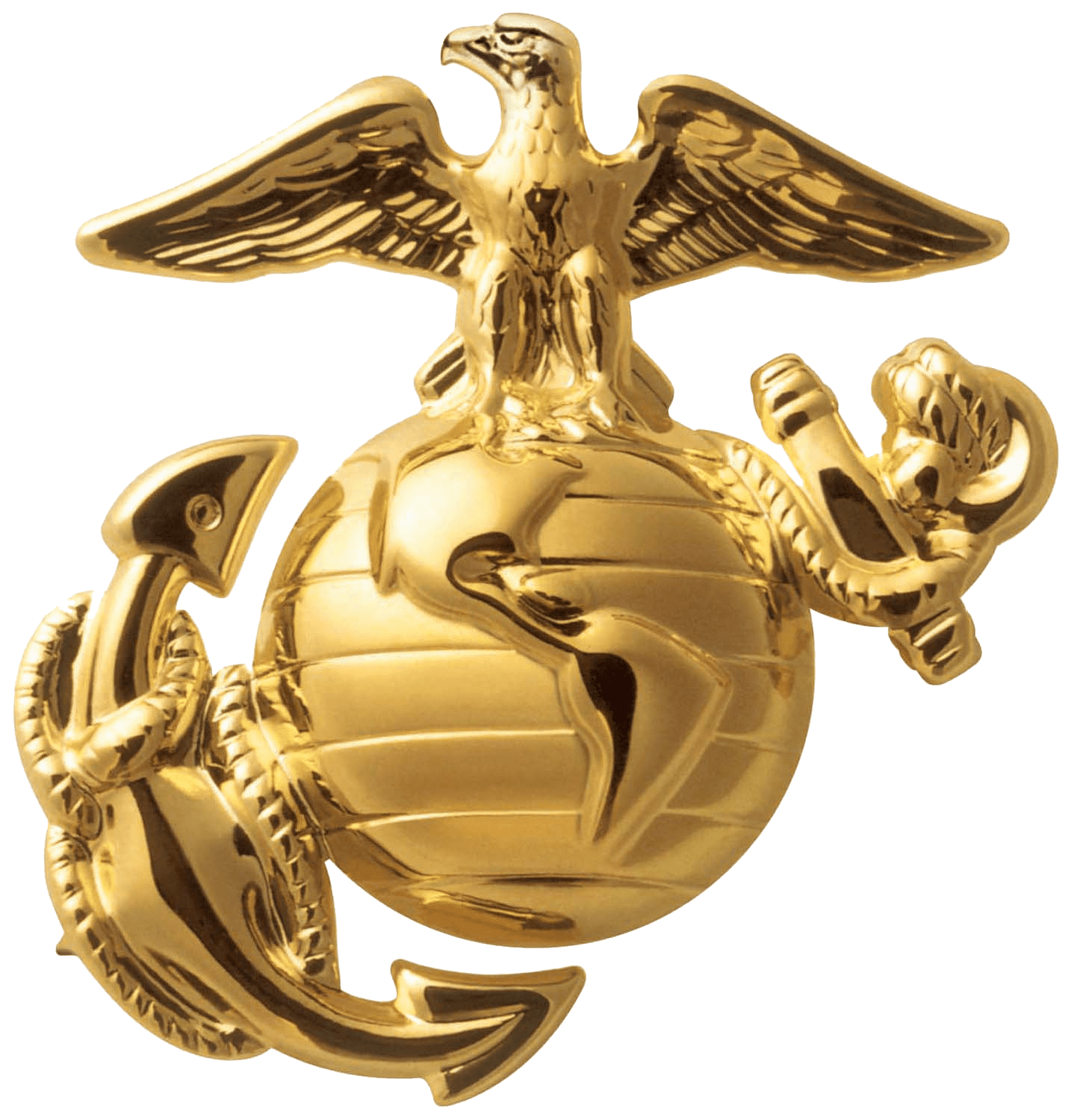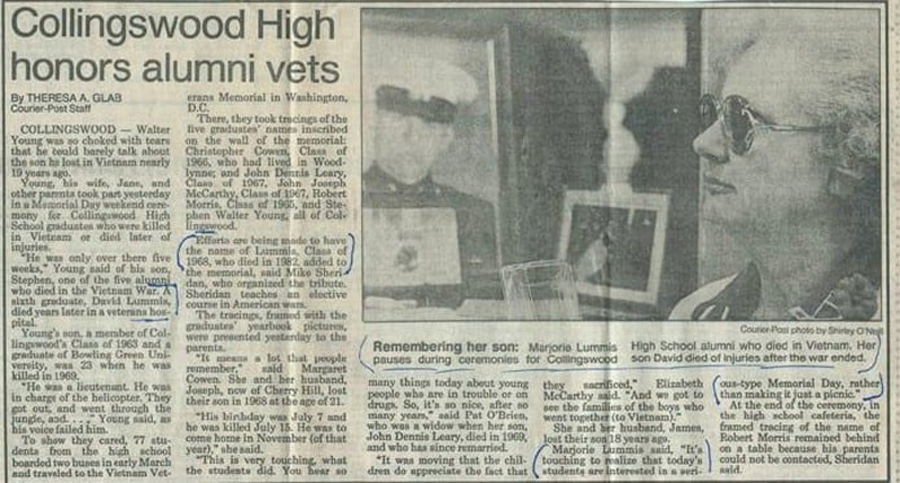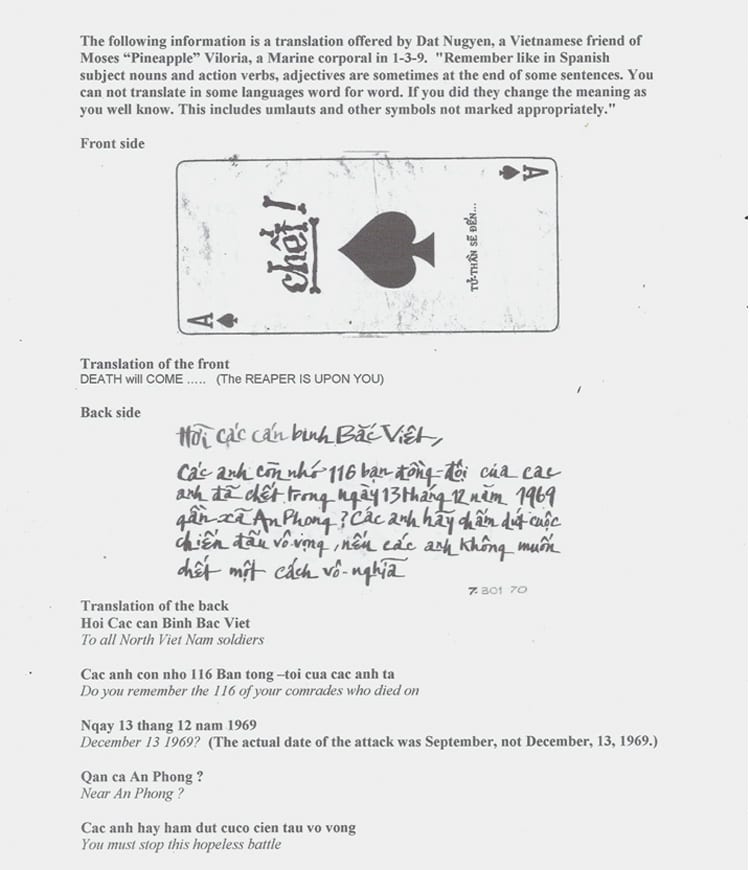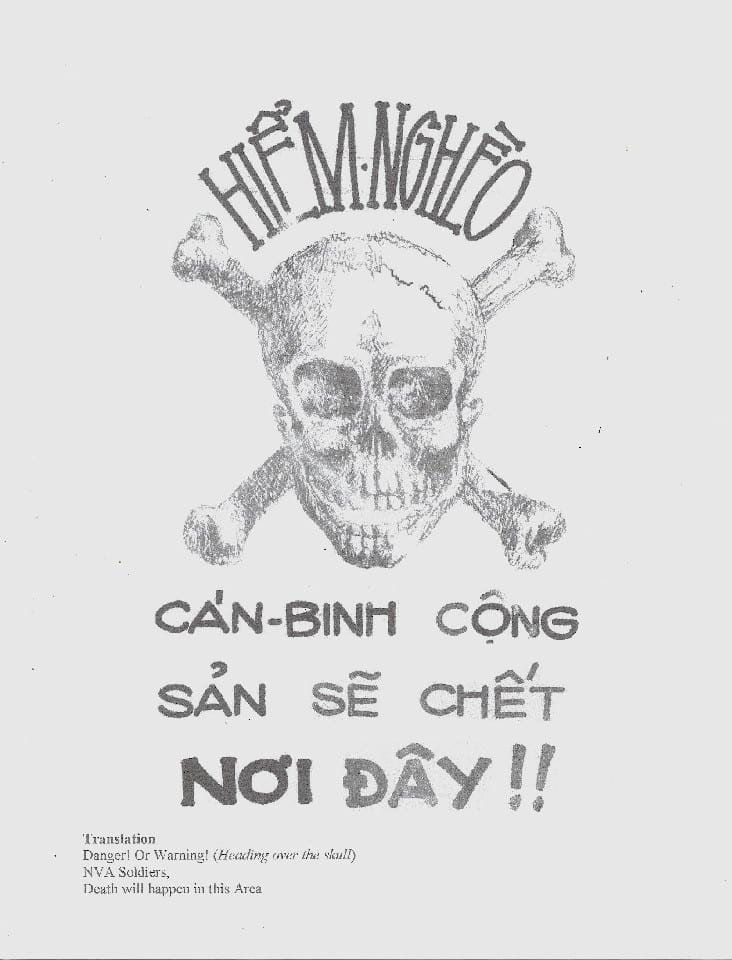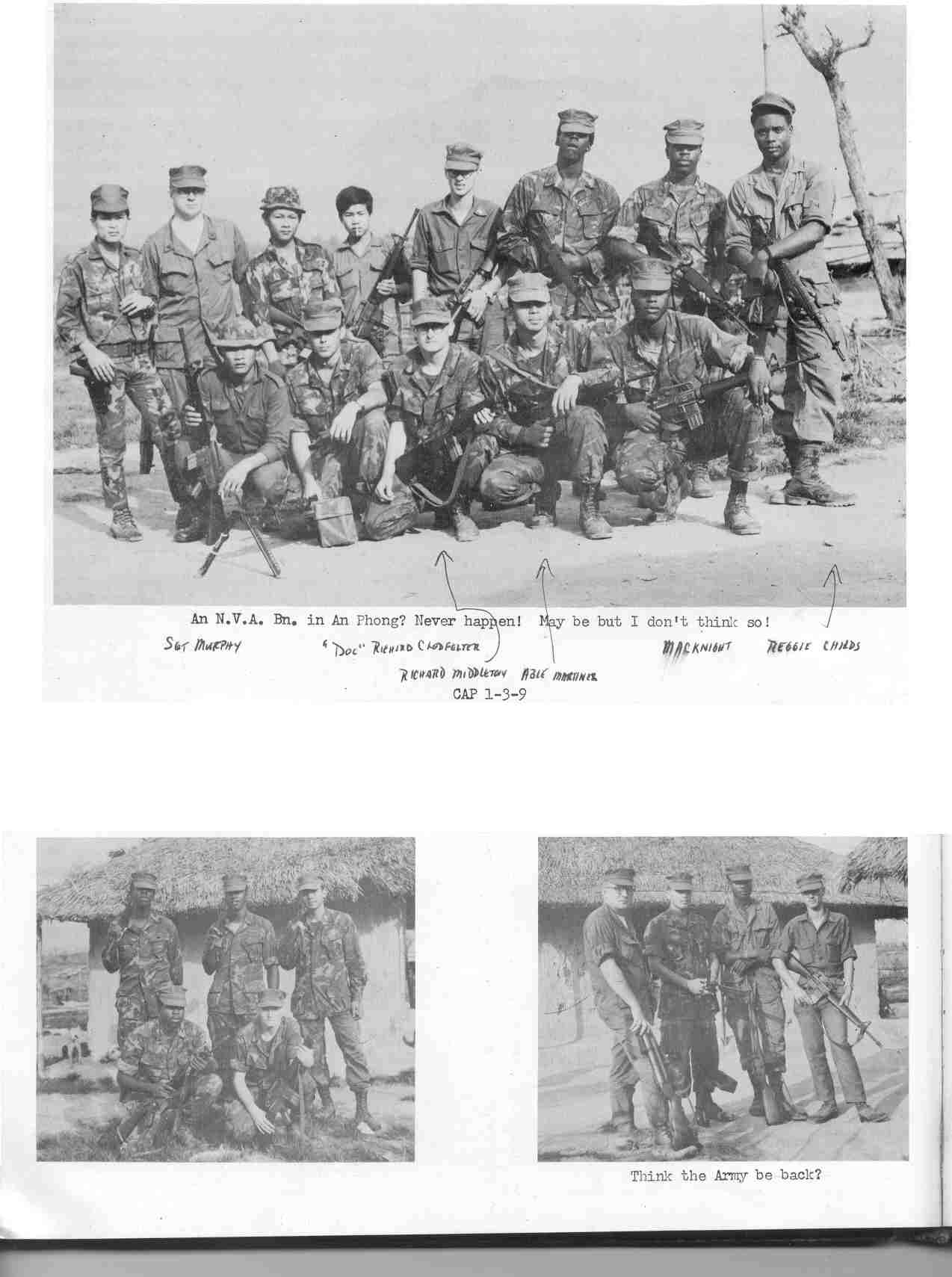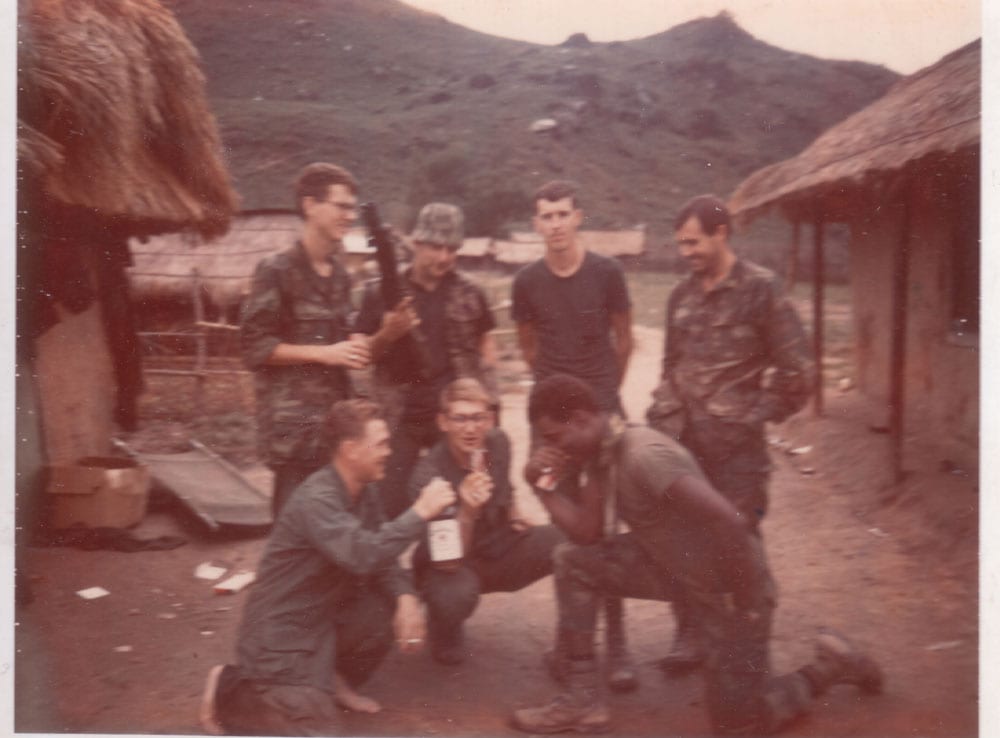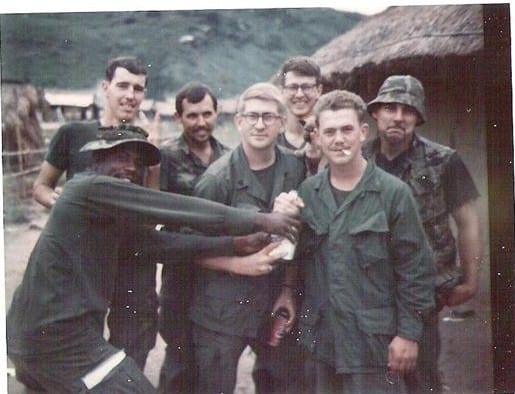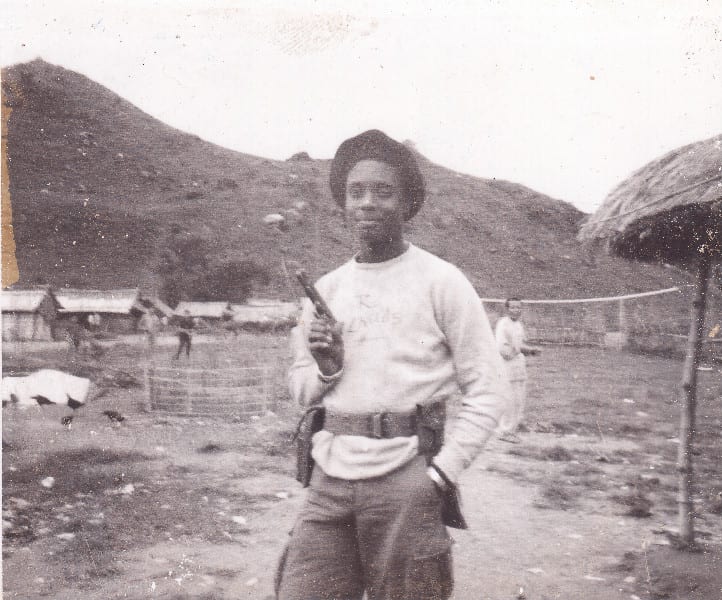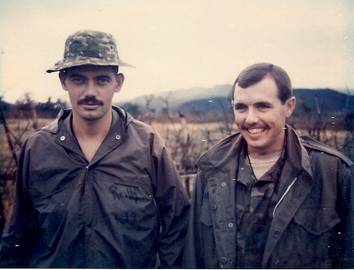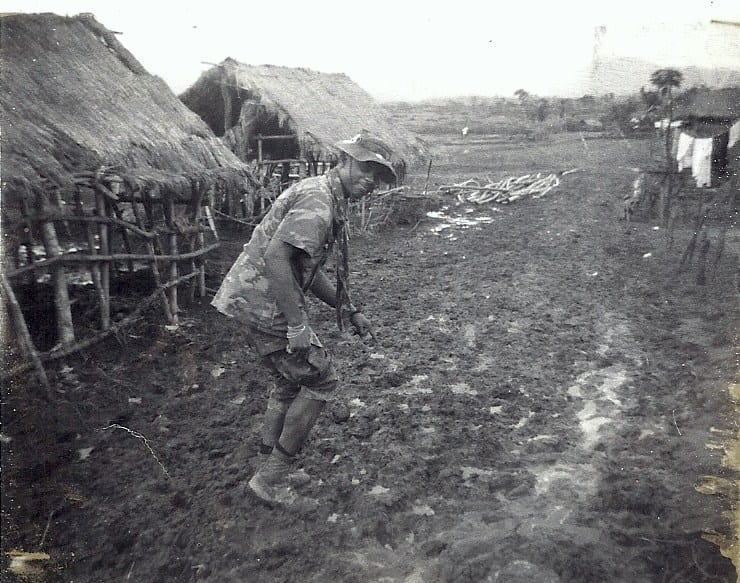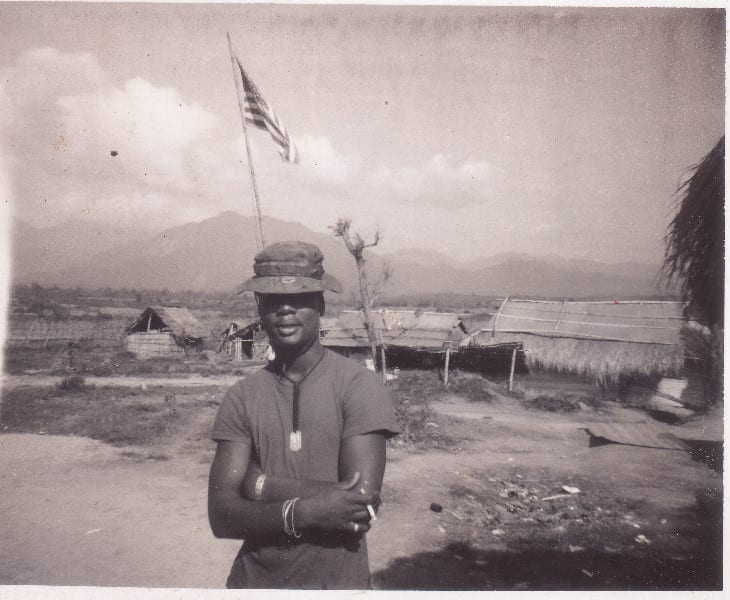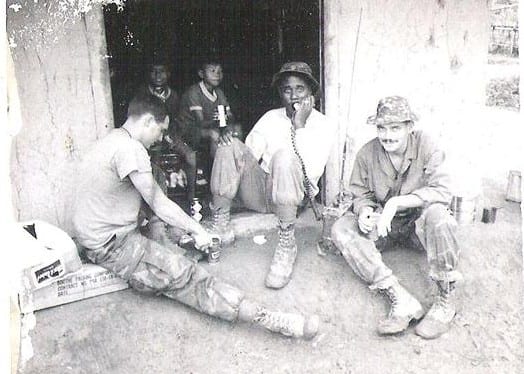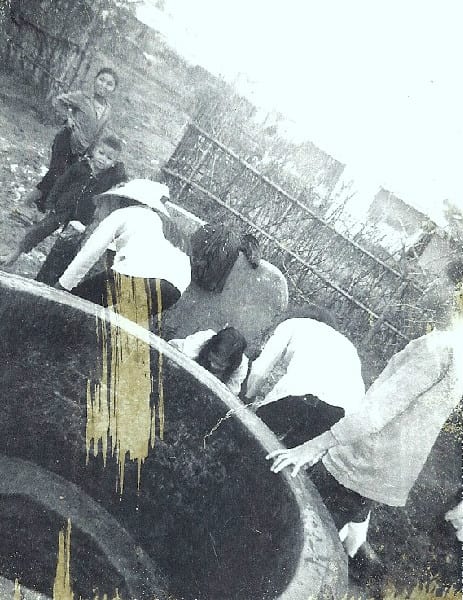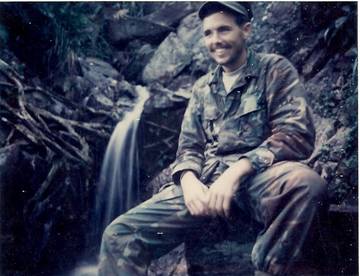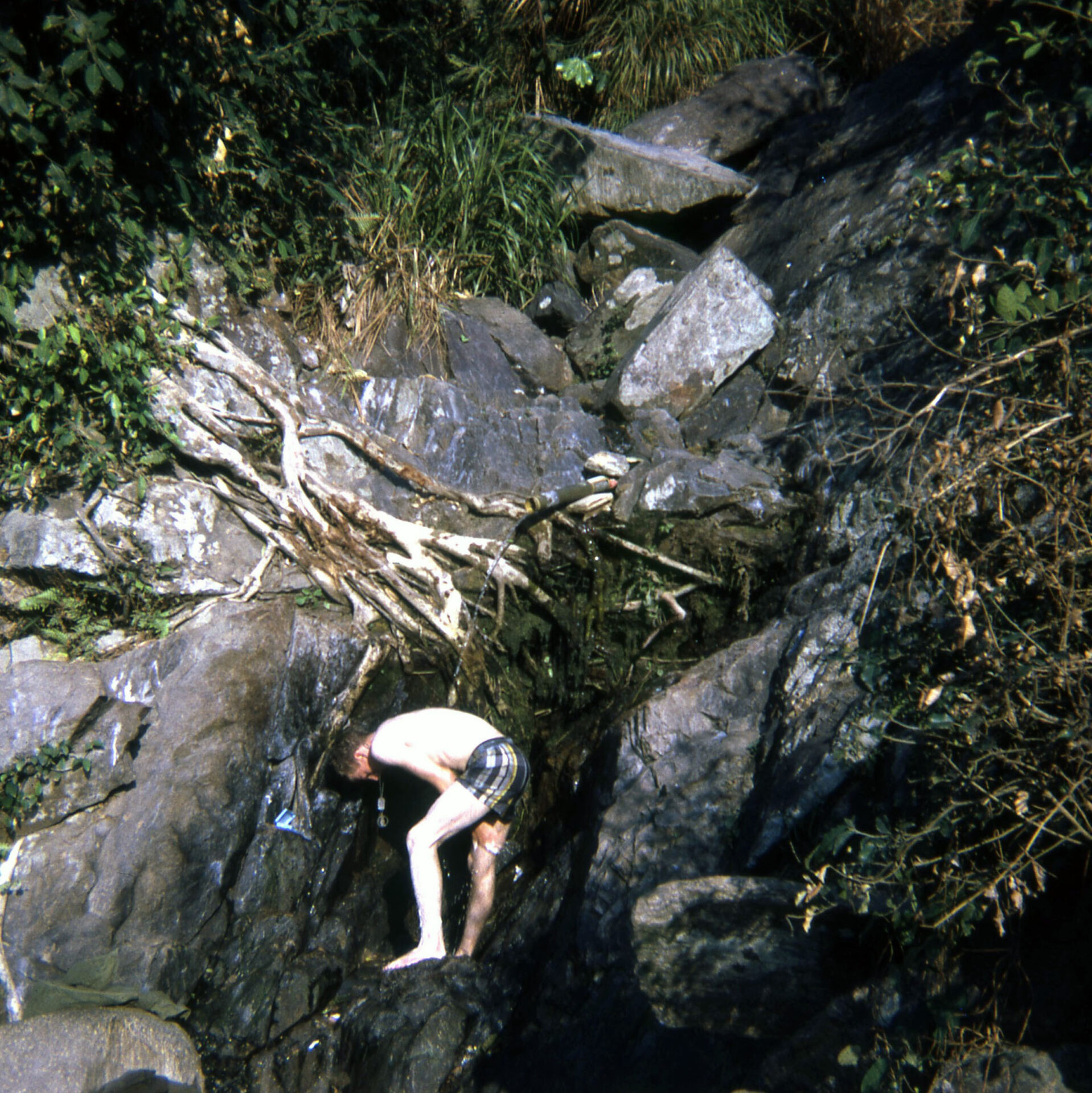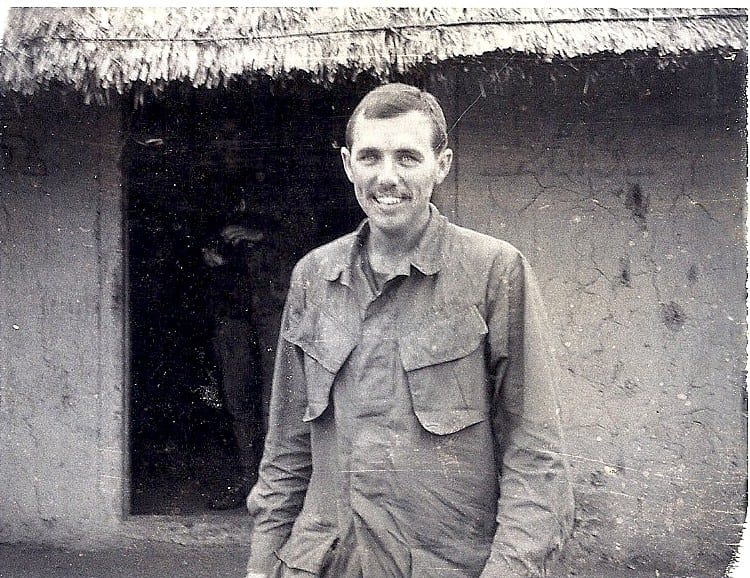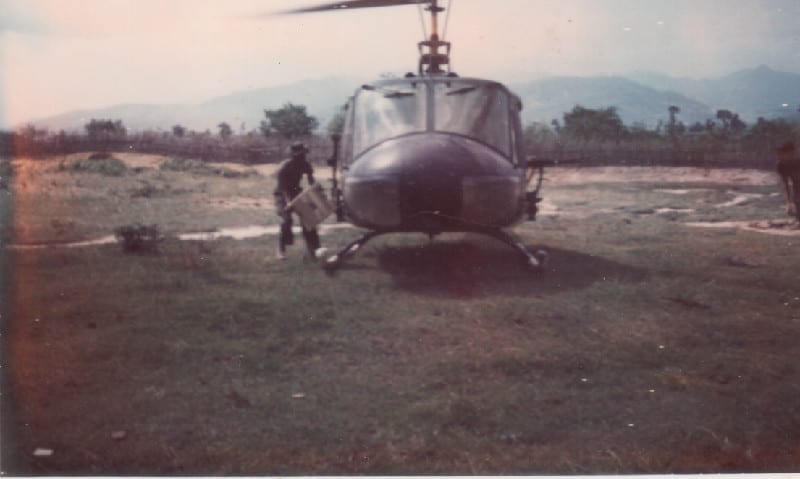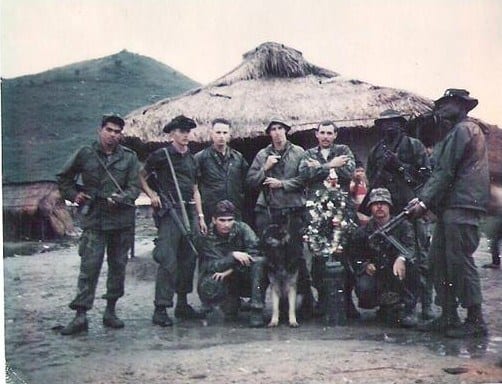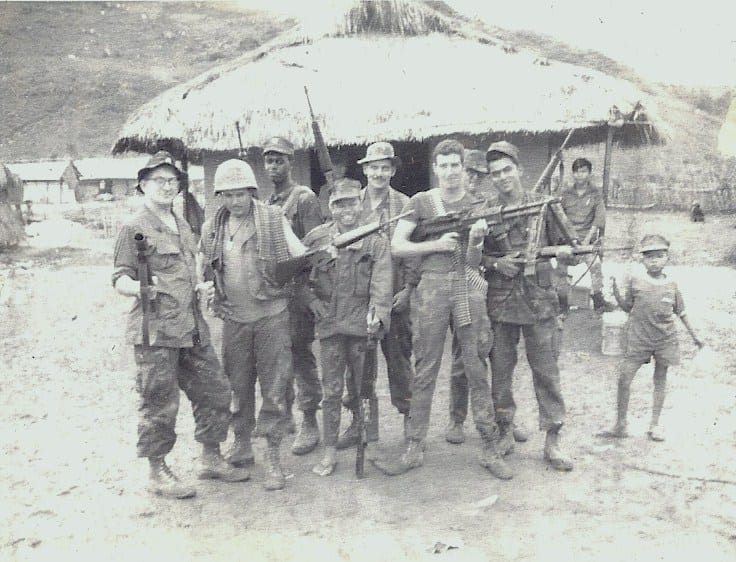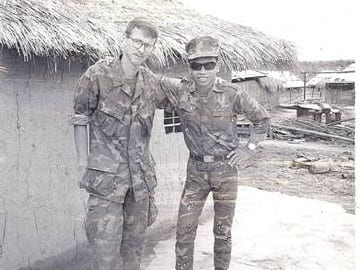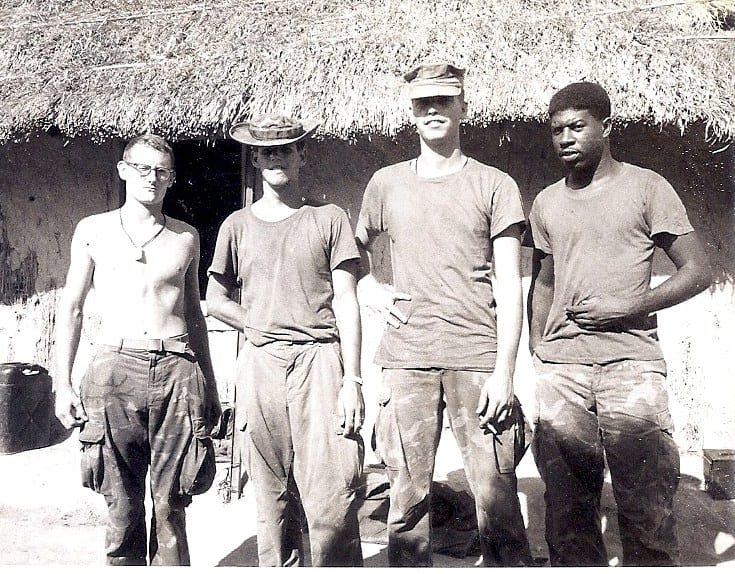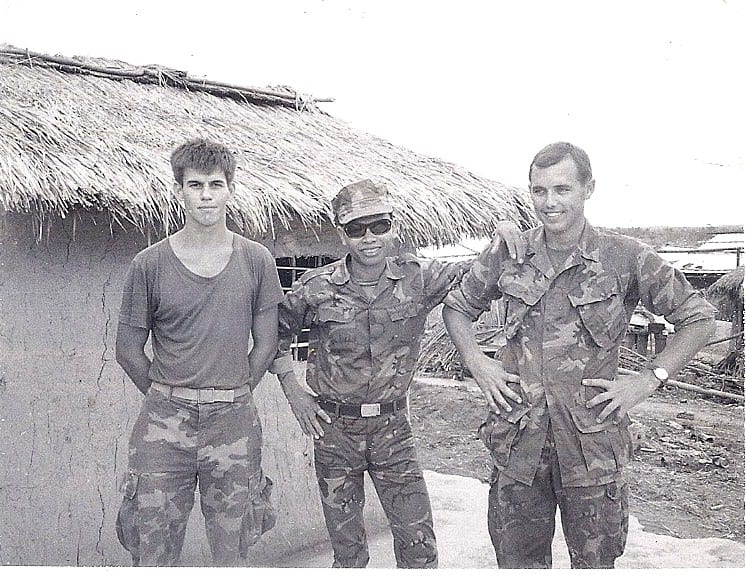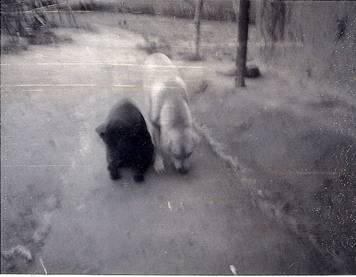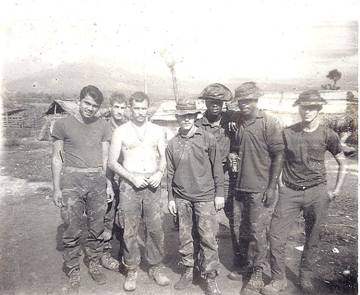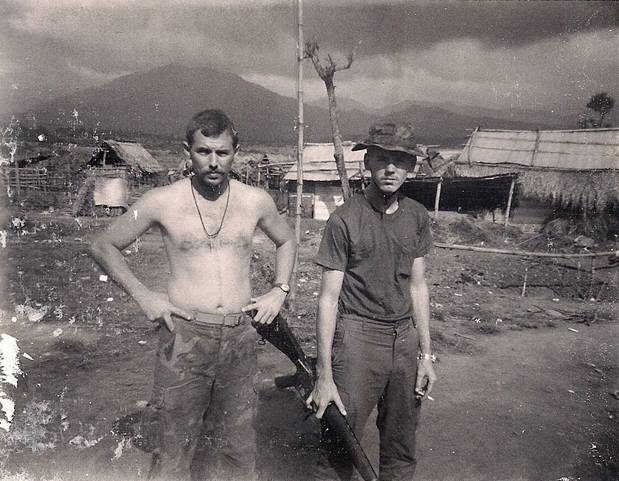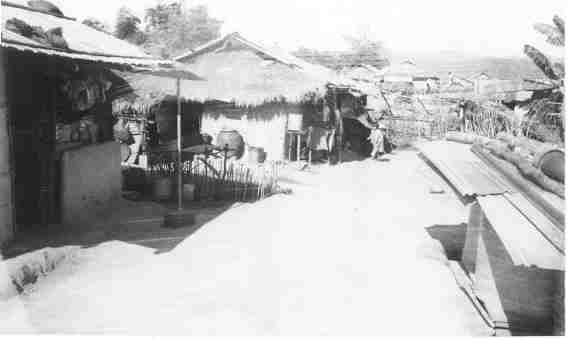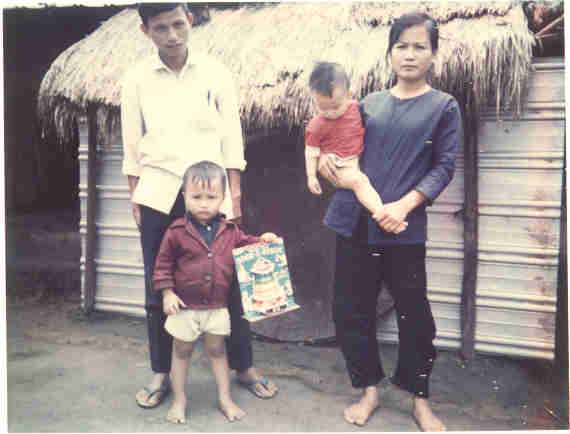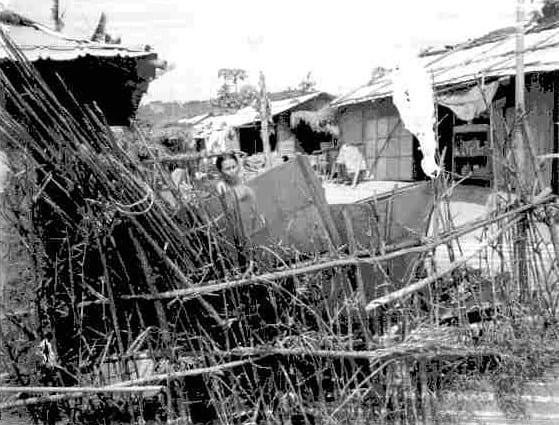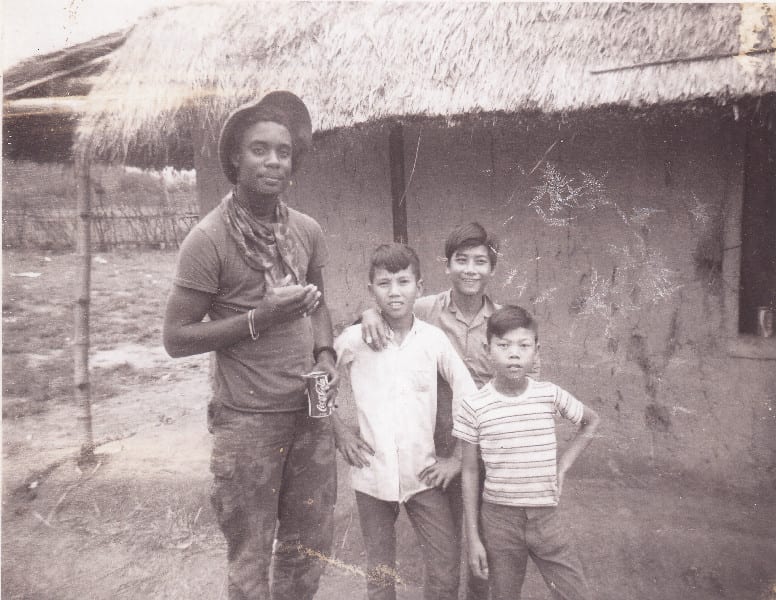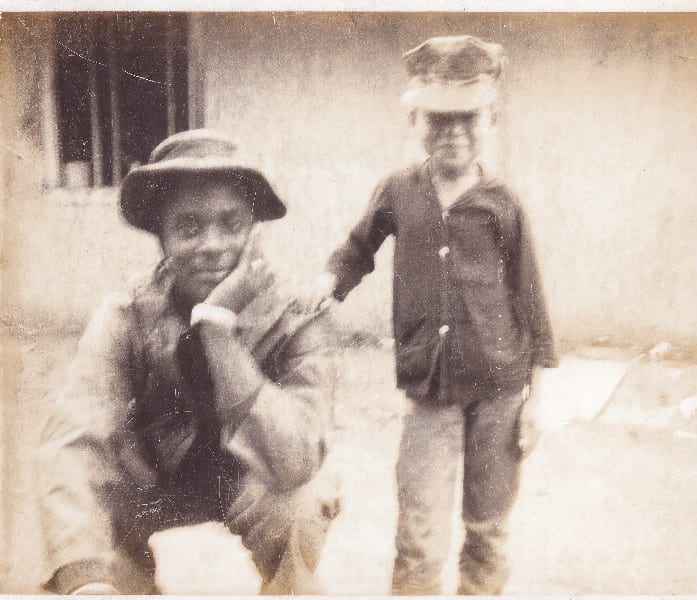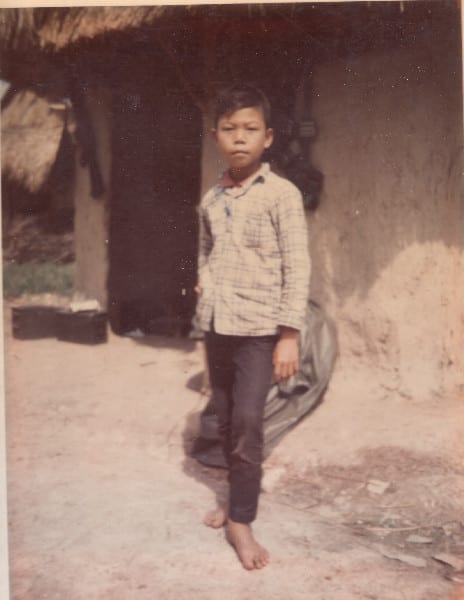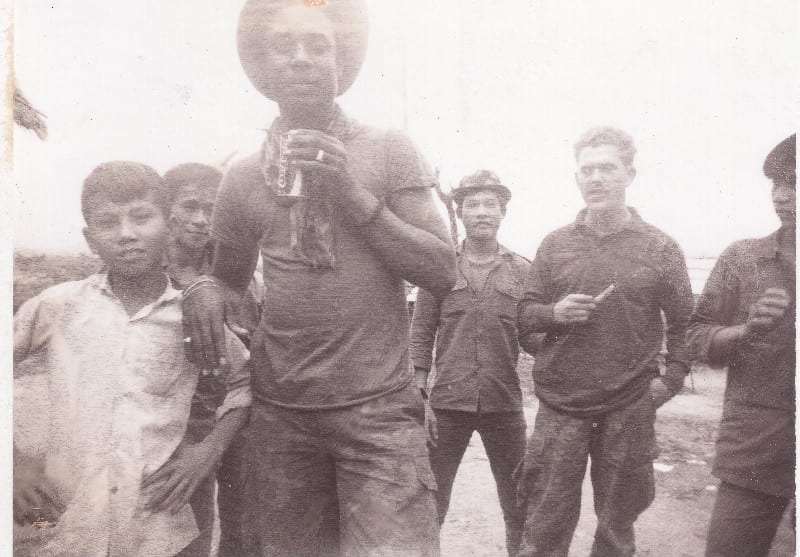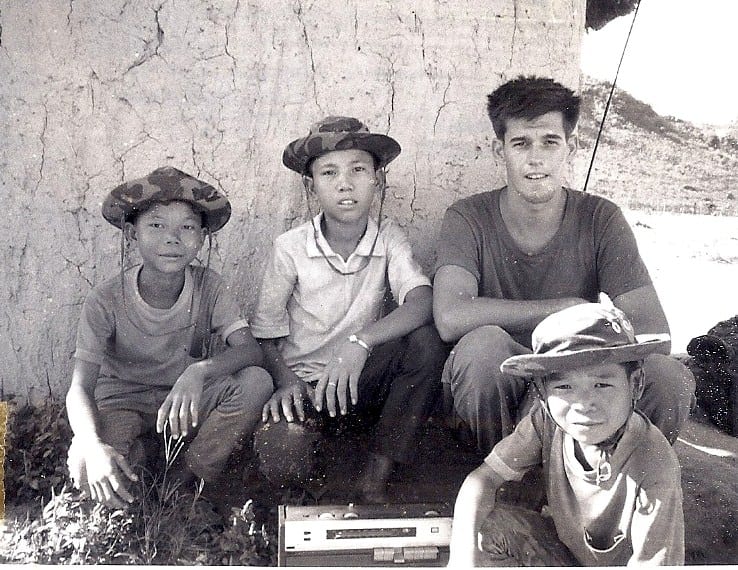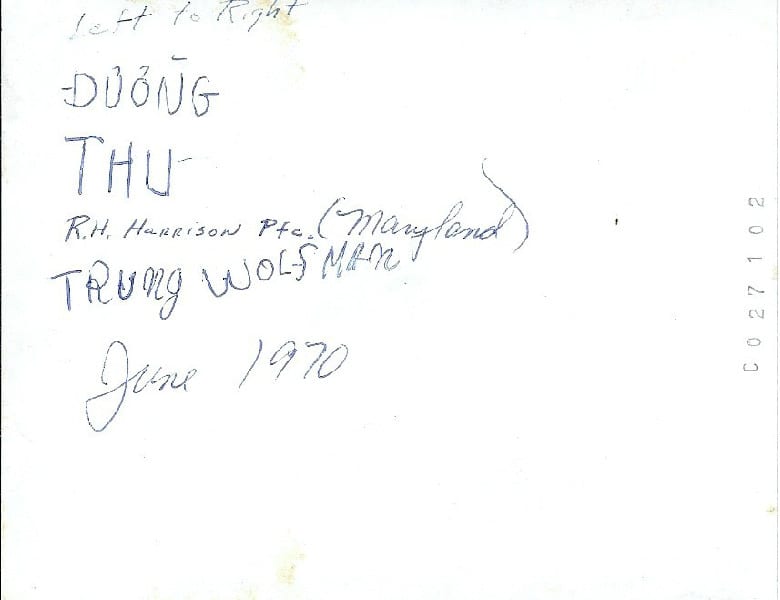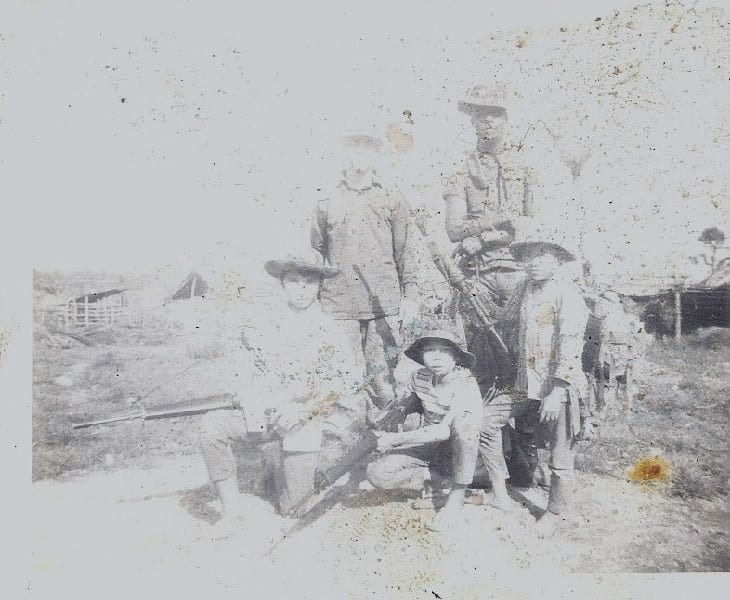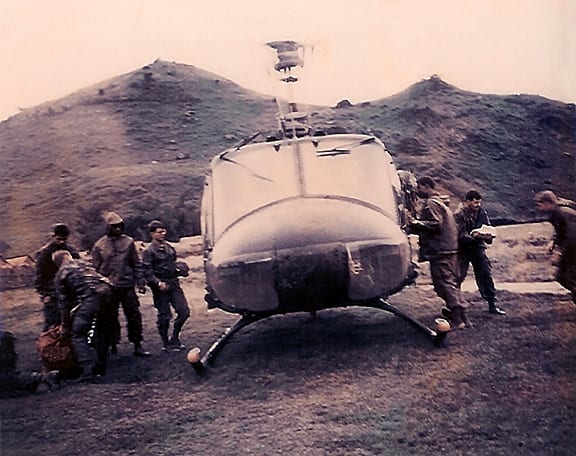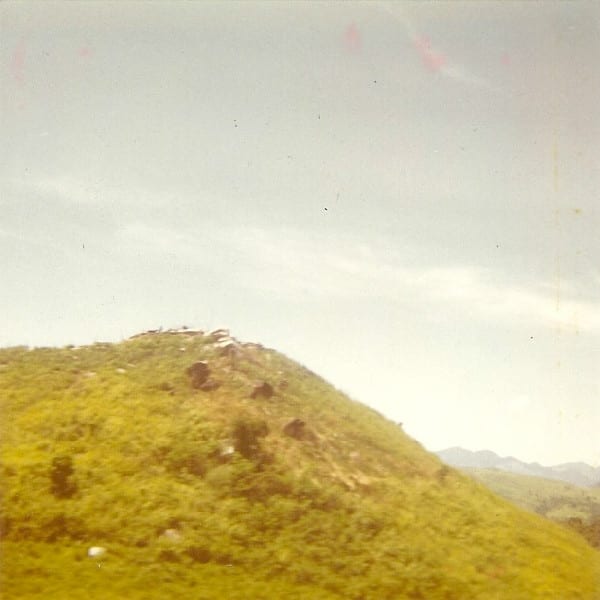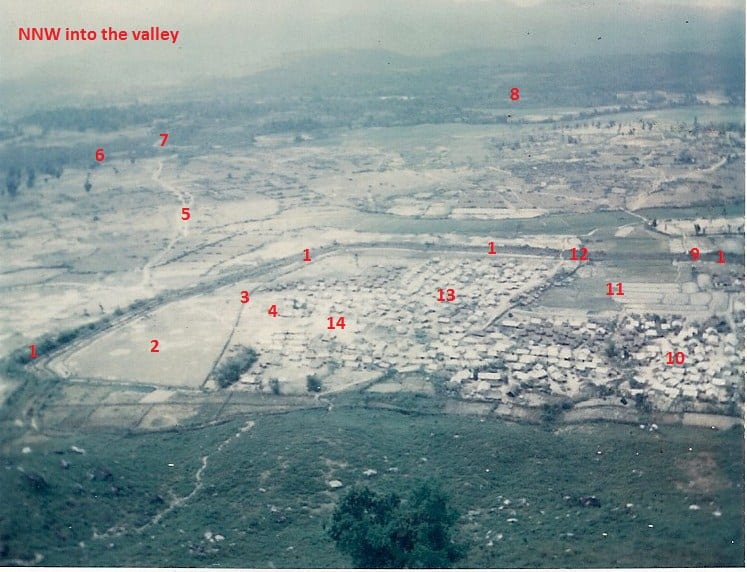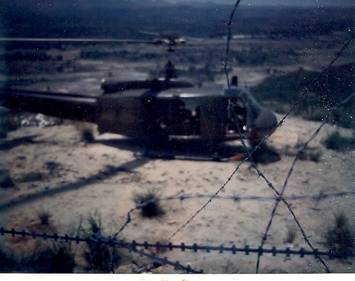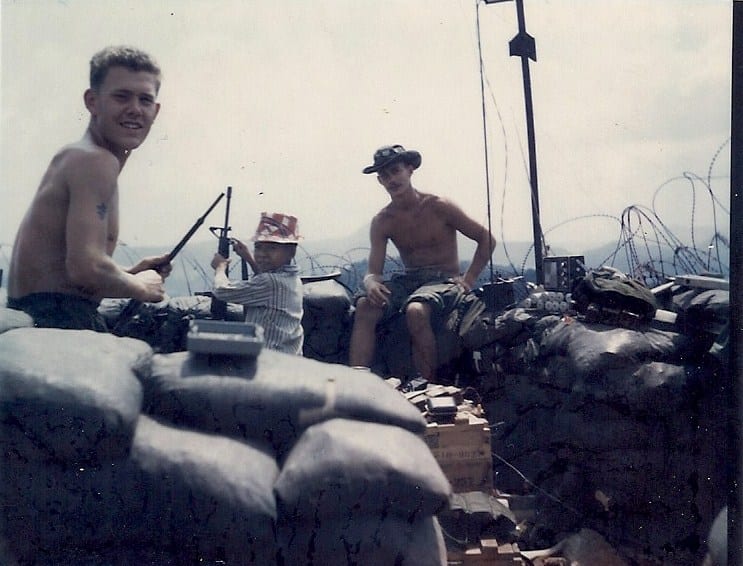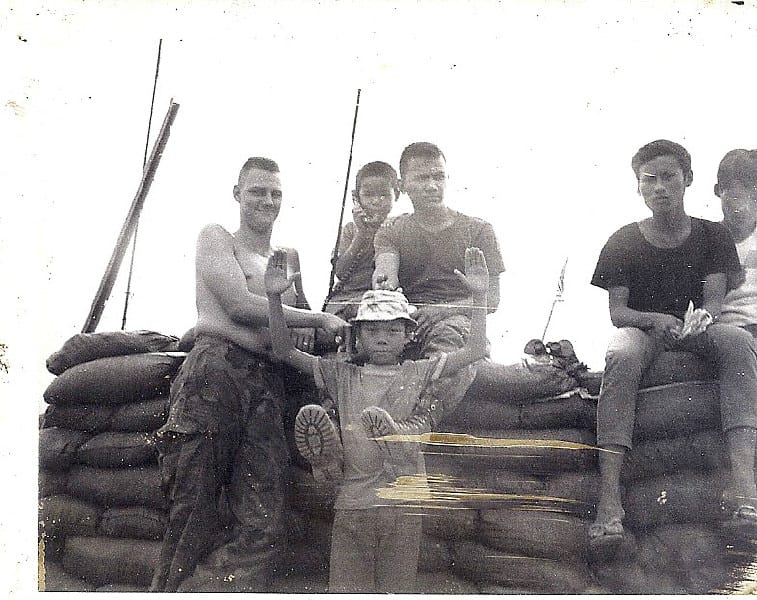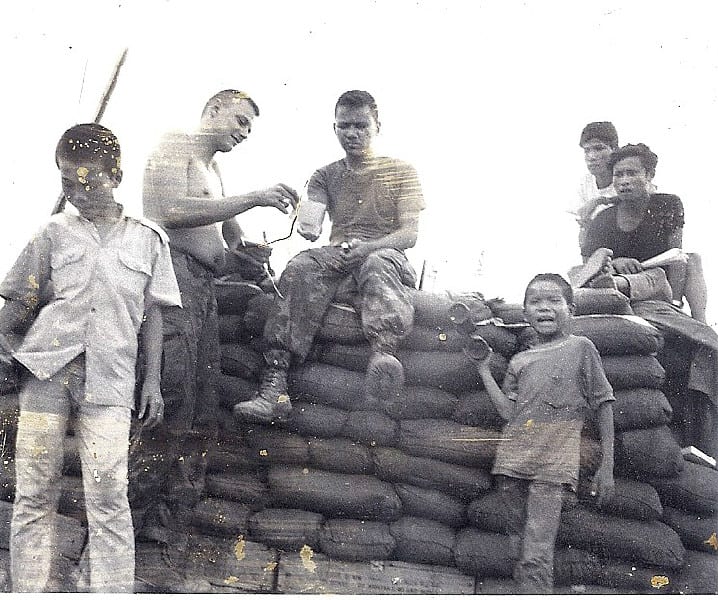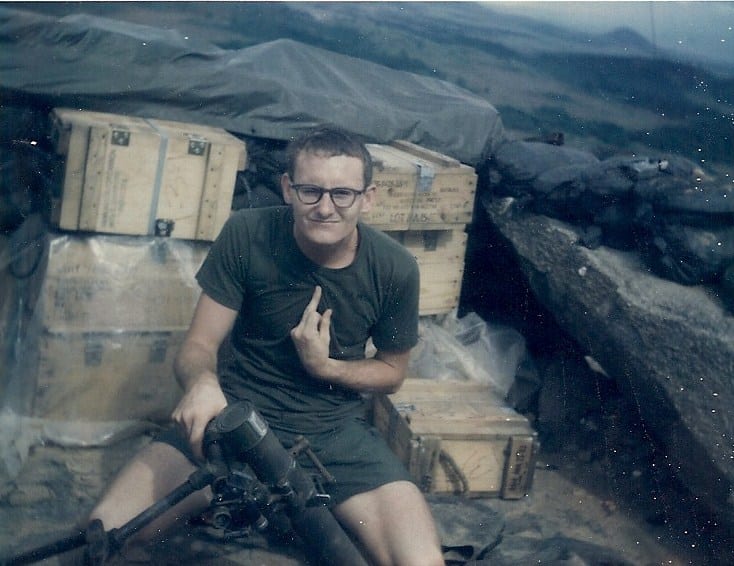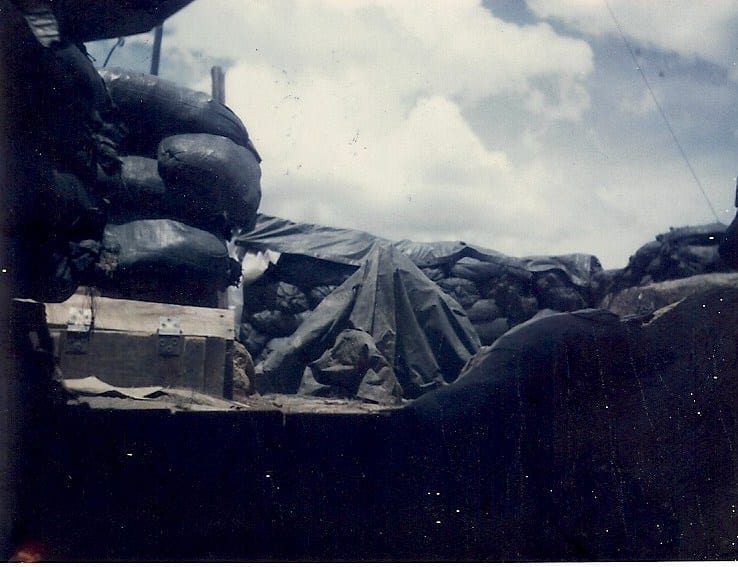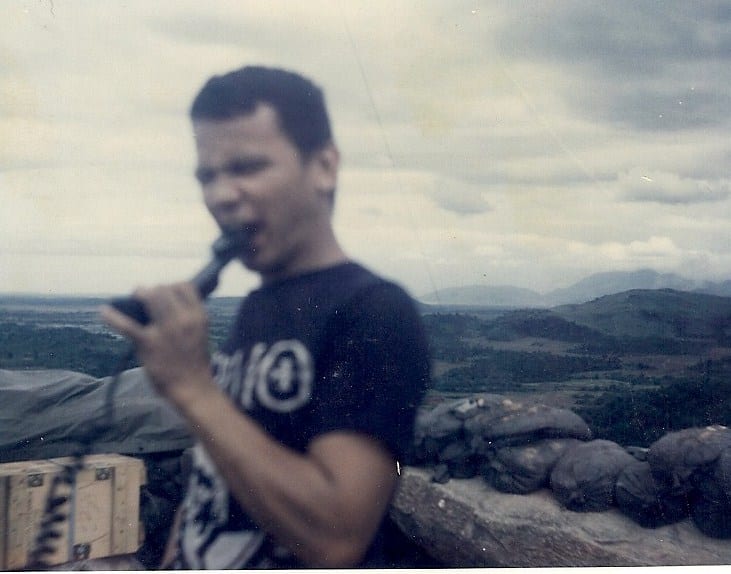AFTER SEPTEMBER 1969
General
Ambushes and Day Patrols
Two ambushes were run each night. The ambushes generally consisted of three Marines and four Popular Forces (PFs). Sometimes we were as low as two Marines and three PFs.
We also ran two patrols a day. They, like the ambushes, generally consisted of three Marines and four PFs.
The NVA and VC generally seemed content to stay in the Tach An Dongs, about four to five kilometers to the east, and the CAP members seldom ventured there.
Americal Division
The American Division, whose area of operations we were in occasionally patrolled in 9's area of operations. There were a few instances when a platoon and possibly a company setup a command post in An Phong for a few days so that would have a base of operations from which to run patrols and ambushes. We didn't run patrols or ambushes when they were there.
Their presence provided the CAP somewhat of a secure feeling but we also were a little uneasy because we knew their 81mm mortars would be a prized target. There was at least once when they actually had artillery with them. Artillery in An Phong, what a concept!
Once they tried to bring a tank from the east. That was a mistake because the tank stayed on the "road,” a dirt path wide enough for two people to walk side by side. It was muddy and the VC could hear it coming from far away. It took a day and a half to move about six clicks from the Binh Son area to the An Diems.
The tank was blown up by what was thought to be a 500 pound bomb that was that was buried under the path. It had to be extracted by a heavy duty helicopter.
Mountainards
We were also visited by a platoon sized unit of Mountainards at least twice and possibly a third time. They were mercenaries who came from the mountains north of the Son Tra Bong River and were led by an Australian captain.
When they would get into 9's area of operations the CAP would start picking up on radio messages from the Australian captain that they were in the area of operation and were going to approach An Phong. This was done because the Mountainards were Vietnamese and the captain didn't want the CAP to fire on them thinking that they were VC or NVA.
The captain always had them set up camp outside the west gate, and they always behaved respectfully.
They were smaller than the average Vietnamese men and looked like they came from a different error in time. Prehistoric might be one way to put it. According to the tallcomanche.org website, "The Mountainards were the aboriginal tribe of people who co-existed along with the Vietnamese in this country."
Air America
There were a handful of times when a silver helicopter (Huey) would unexpectedly land in the 1-3-9 landing zone (LZ). The helicopters were part of the Air America program, which in turn was part of the Central Intelligence Agency (CIA).
A couple people who appeared to be civilians would get off the helicopter and move directly to the hooch they intended to inspect. There was no hesitation in what they did and only minutes passed from when they landed until they took off again, only they left with one extra person. Each time that extra person was a Vietnamese man who the Air America personnel knew had intelligence that was needed. Only once did they leave without the person they were there to get, and that's because he wasn't there at that time.
The Vietnamese men that were taken for interrogation never returned to the village.
This was, as the following information taken from the Air America official website, a highly secret program.
"From 1946 to 1976, Civil Air Transport (CAT) and Air America served alongside U.S. and allied intelligence agents and military personnel in the Far East, often in dangerous combat and combat support roles. Behind a shroud of strict secrecy, many Air America personnel were unaware that they were "shadow people" in counterinsurgency operations."
Village Drummers
A male village drummer would be positioned at each gate during nighttime. His job was to let the ambush teams out and in the village and to alert the Marines and Popular Forces if he suspected VC or NVA were outside his gate. No drumming meant no concern, but if there was drumming there was a concern. The faster the drumming the more concerned the drummer was that there were VC or NVA near his gate.
It was a rudimentary warning system, but it's what was available and it served its purpose well with the exception of one time.
The lone exception was when the drummer at one of the middle gates started drumming very fast and the Popular Forces commenced firing... at the ambush team that was positioned about 150 meters immediately in front of the gate. Fortunately, the ambush team led by L/Cpl Jerry Meyer was able to get behind a rice paddy dike and not sustain any injuries.
Fall 1969
Sgt. Murphy was directed to regain the villagers’ trust by not overly engaging the enemy. The CAP kept the village and villagers safe by running ambushes and patrols in the vicinity of An Phong instead of being more aggressive and going to the Tach An Dongs. The strategy worked.
Winter 1969/70
Dog Handler
A dog handler arrived from what must have been the 1st Marine Division shortly before Christmas 1969. The CAP didn't know he was coming. He just showed up on a resupply chopper one day. He trusted his dog, a German Shepherd, very much and ran at least two day patrols to the Tach An Dongs with his dog and without anyone else. He was with 9 about three to four weeks and then sent to another unit.
January 1970
January 1970 was a tough month for the CAP. David Lummis was injured severely when a mine exploded and Oliver was also injured severely.
Lummis stepped off the trail near the top of 9 George, stepped on a mine and lost the lower part of his body. He was medevaced to Chu Lai where he received direct transfusions from other Marines, Middleton included, with the same blood type. David was then sent back to the Philadelphia Naval Hospital for treatment. He later died from his injuries. Please read the following two articles.
Oliver's rifle went off while the night ambush team he was on was going through one of the middle gates. The round went through his foot, and he was sent back to the World after being treated in Vietnam.
LOH and Gunship Patrols
There were many times when Light Observation Helicopters (LOHs) would work the tree line about 1 to 1.5 clicks north of the village around 1700 hours. This was in our A/O and we would watch them from An Phong.
A single LOH would hover just above the trees and then move to another group of trees until it drew small arms fire, probably from a lone VC. The LOH would then depart the area and a gunship would be on site in a minute or so. The gunship would then work the area and depart when its job was done.
None of the LOHs, even though they were immediately above the trees from which the small arms fire came, were shot down. That was a crazy strategy.
Airstrikes in the Mountains to the West
A mountain range running south to north was about 7 clicks to our west. Its northernmost section entered the Tra Bong Valley.
There were several consecutive days during the fall or winter when numerous fixed wing airstrikes were conducted on the east side of the mountain range. We were able to watch them from the ville much as if we were watching a war movie at home.
One jet was shot down and we saw the pilot bailout. His chute opened and he landed safely. It wasn’t long after that that a helicopter rescued him and brought him to An Phong.
Upon landing in An Phong, a few crew members and the pilot exited the helicopter. The pilot was checked out; everyone got back in the helicopter and took off.
Landing in An Phong, “Home of the Forgotten,” made no sense because the once over that the pilot was given in our LZ amounted to nothing and certainly could have been done in flight. They could have continued flying and been in Chu Lai or Quang Ngai, secured areas with trained medical personnel and facilities, in five minutes longer than it took to complete the once over.
Spring 1970
Death of the Village Chief and His Wife
The village chief and his wife both died one day when a hand grenade exploded between them. Their bodies from the abdomen down were shredded so badly that they internal organs were clearly visible. Medevacing them made no sense.
As they were dying, blood oozed out as their hearts continued to pump. A yellow dog kept coming to where they were to pull on and eat their innards. He was run off several times and eventually stopped coming back.
Spring Tax Ambush
The villagers of An Phong were peasant farmers and had little if any money. They were poor to the point that none of them, not one, had a bicycle to transport their rice to the market in Binh Son. They walked the 14 clicks from An Phong to and from Binh Son everyday during harvest time, carrying their goods every step of the way.
In the spring, possibly March, the villagers were returning at the end of the day and complaining that the VC were stopping them just north of the Tach An Dongs to "tax" them. They didn't like that, told 1-3-9's interpreter, But, and But told us about it.
Sgt. Murphy told L/Cpl LeBlanc to put an ambush together and, "Go down there and stop that shit."
The ambush was much larger than normal and consisted of LeBlanc, L/Cpl James McKnight, PFCs Able Martinez and Mike Carter and about five or six Popular Forces. The ambush left An Phong around 0300 and arrived at the ambush site, a tree line south of the path the villagers used to get to the market in Binh Son. The tree line was north of the Tach An Dongs by about 100 meters and was where the villagers indicated they had been stopped during the two or three days prior.
The ambush was setup in a line paralleling the path with alternating Marines and Popular Forces facing to the front and rear.
Four or five VC and another individual walked into a small clearing at the western end of the ambush, saw us, turned around, and walked right back into the tree line from which they came. The team leader swears the other individual with the VC was North Chinese and not Vietnamese. He was built like Sgt. Murphy, about 5'9" and 170 pounds and had a distinctively different face than Vietnamese.
The ambush opened fire with small arms, automatic weapons, and a Light Antitank Assault Weapon (LAAW). The VC were seen heading south and the ambush opened fire again. The VC took cover behind some thick bush/palms. The North Chinese was the only one who was seen after they took cover. He boldly stepped to the right of the palms to see what was happening each time the machine gun jammed. Unfortunately he did not get shot, but fortunately the villagers weren't taxed anymore.
Chicom Incident
A lone VC threw a chicom at an ambush team in the spring of 1970 as they were going out the bamboo gates of the middle hamlet. The chicom landed at the feet of the team leader, was thrown to the side, and thankfully did not explode. The VC escaped into the night, and the ambush went on as scheduled.
Psychological Operations (PSYOPS)
The Ace of Spades leaflet was dropped in CAP 1-3-9's AO in the spring of 1970 because 1st CAG had intelligence that the CAP was going to be attacked by a large NVA force. The NVA were said to be on bicycles, which caused the CAP to take the intelligence less seriously. The attack, or any related activity, in CAP 1-3-9's AO never happened.
Our interpreter, Ngyuen But, said that the NVA and VC believed that the souls of their 116 comrades who died were trapped between the fences surrounding the village and because the Vietnamese were a superstitious people, they probably did not return because of that.
In retrospect, while the CAP somewhat discounted the intelligence due to the bicycle info, it could very well have been accurate because as it turns out, part of the AO was a resupply route and bicycles were used to move supplies. Either no attack was planned or the PSYOPS leaflet worked for CAP 1-3-9.
Combined Operation with CAPs 1-3-9 and 1-3-2; May 1970
CAP 1-3-9 was supposed to be overrun by a very large NVA force in the spring of 1970. CAP 1-3-2 was overrun on May 8, 1970 by elements of the 21st NVA Regiment. It’s speculation on my part but the PSYOPS that were done in 1-3-9’s area of operations (Ace of Spade and Skull and Cross Bones) and the following combined operation may have caused the enemy not to attack 1-3-9 in An Phong but to attack 1-3-2 instead. As a side note, Cpl. Frenier was meritoriously promoted to corporal and received the Silver Star for his actions on May 8 with 1-3-2 when elements from the same VC and NVA units attacked 1-3-2.
The following is a recap of a joint operation involving CAPs 1-3-9 and 1-3-2 on May 5, 1970 as noted in the 1st Combined Action Group (CAG) Command Chronology for the period 1 May 1970 - 31 May 1970. Additional information was obtained through interviews with Cpl. Bob Reilly and L/Cpl Rick Middleton from 9 and Cpl. Dave Frenier, the CAP Commander from 2. Reilly and Middleton have good reason to believe this took place in June, but the Command Chronology was for May. No mention of any operation by either CAP was in the June Command Chronology.
Captain D. L. Lapham, Sgt. L. Meyers, Cpl. Bob Reilly, and a few others were choppered from CACO 1-3 in Binh Son to CAP 1-3-9 on May 4, 1970. This was done to reinforce the CAP for a patrol into the Tach An Dongs the next day. Corporal Bob Mason was 1-3-9’s CAP Commander.
One of the ambushes went out the west gate on An Phong the night before the patrol. The ambush was fired upon but no casualties were taken.
CAP 1-3-9, reinforced with the personnel from CACO 1-3, left An Phong around 0300 and headed east on the trail that led to Binh Son. Several of the Marines were new in country. They arrived in the Tach An Dongs about daylight.
CAP 1-3-9 entered the Tach An Dongs from the west and 1-3-2 entered from the east.
Lance Corporal Rick Middleton was on the right flank as security. He had a PRC -25 radio with him. Corporal Reilly and Richard “Doc” Clodfelter, the CAP’s corpsman, were with him. Doc tugged Middleton’s leg to alert him to an approaching VC. Middleton states that he was the only friendly standing, but that the VC couldn’t see Middleton because the morning sun was glaring in the VC’s eyes.
Middleton shot the VC. Other VC opened up on the CAP immediately after that. Rounds were flying all around 1-3-9 and sniper fire was being received from several locations. Sergeant Meyers was carrying the M60 and was shooting widely from the hip. Corporal Marcelli (sp?), as Middleton states was shot, “right through the face.” He was medevaced shortly after being wounded. Corporal Frenier stated that, “it was a million dollar wound” because it wasn’t a life threatening wound, he was new in country, and this ended his tour in Vietnam because he was medevaced to Japan. The round that hit Corporal Marcelli passed through his mouth and neck without doing any major structural damage.
Corporal Reilly mentioned to Captain Latham that they needed to get out of there because Reilly, having been a member of 1-3-9, knew that the Tach An Dongs were the 21st NVA’s regimental headquarters and that 9 and 2 could be greatly outnumbered very quickly.
Both CAPs then proceeded back to their areas of operation with the 1-3-9 reinforcements returning to CACO 1-3 headquarters (Binh Son) with 1-3-2.
The results were one VC KIA, no VC WIA, and one Marine WIA with no friendlies being KIA.
The joint operation may have contributed to the NVA and VC from the Tach An Dongs making a retaliatory attack against 1-3-2 on May 8th. CAP 1-3-2 was overrun that night by elements of the 21st NVA battalion. Their CAP commander was unable to respond when the attack started and L/Cpl Dave Frenier, the second in command, rose to the occasion in true Marine Corps fashion, and led 1-3-2 throughout the night as they fought and soundly defeated the enemy despite being vastly outnumbered.
More information about CAP 1-3-2, including their May 8, 1970 battle, may be found by clicking on CAP 1-3-2.
Summer 1970
June Helicopter Incident
LeBlanc replaced Moses "Pineapple" Viloria on Fire Support Stinson as the Marine in charge of the daily resupply run for CAPs 1-3-2, 1-3-5, 1-3-8, and 1-3-9.
A Light Observation Helicopter (LOH) had to be used one day in the middle of June because Hueys weren't available. The Army pilot, a warrant officer, left 1-3-2 and headed west to 1-3-9. That was the routine, and the VC and NVA in the Tach An Dongs and An Diems, a series of hamlets in the eastern part of 9's area of operations, knew it well. The pilot chose to fly immediately above the tree line running north and south. That was a huge mistake because it made the LOH highly vulnerable to attack.
The helicopter drew fire from four VC as soon as it cleared the western edge of the tree line in the An Diems. The VC were led by what was believed to be a North Chinese advisor. LeBlanc had seen him before in the same area while assigned to 9. The helicopter was riddled with rounds fired by the four VC and the pilot had to make an emergency landing. He made the landing at 9 because it was the next closest location and he wasn't sure he could turn the helicopter around and make it back to Binh Son, Chu Lai, or Quang Ngai, all of which would have been safer locations.
The pilot inspected the LOH at 9 and determined that it was flight worthy despite hydraulic leaks and no communications ability. Neither the pilot nor the Marine were wounded but there were rounds that literally missed them by an inch or less. The pilot told LeBlanc that if anyone asks that we were flying at 1600 feet, when in fact 60 to 80 feet would be more like it and 60 would be even closer.
Late June Interrogations
Corporal Middleton reports that CAP 1-3-9 again went to the Tach An Dongs, this time in late June. When they arrived fighting aged men were not in the village, only women, children, and older men. The CAP took about 30 to 40 of them back to An Phong for interrogation by the village chief. They were held in the old school house pending their interrogation. This took the rest of the day and into the next day. The CAP didn’t run any night ambushes that night because it was needed to keep the detainees secured in the school house. As Middleton states, ambushes weren’t run because the CAP highly suspected that a significant number of the fighting aged men from the Tach An Dongs were just outside An Phong and the CAP didn’t want to engage them.
July 9th in the Tach An Dongs
Corporal Mason led an ambush that left An Phong around 0200 – 0300 hours and went into the Tach An Dongs. Three other Marines, L/Cpl Middleton, Hailey, Hood and about 6 to 8 Popular Forces comprised the ambush. The CAP had been there about two to three weeks before and had taken a lot of the villagers back to An Phong for interrogation.
The ambush began leaving the Tach An Dongs when the PFs left the Marines to get out of the area. Shortly after they left, the enemy opened fire on the Marines and Hailey was shot in the tricep. L/Cpl. Middleton applied a battle dressing and asked Hailey if he could still shoot. Hailey replied yes so Middleton headed back to where Cpl. Mason was.
Cpl. Mason was shot shortly after Middleton got back in the area. Cpl. Mason had some shrapnel in his ear from an enemy round that had to have been meant for Middleton. The round came within inches of Middleton and hit the PRC-25 Cpl. Mason was carrying. L/Cpl. Middleton heard him calling for help, turned around and found out that the round had blown both frequency control knobs off the PRC-25. Fortunately, the radio still worked.
Four gunships arrived on site and worked in pairs. The pilot told Cpl. Mason to pop smoke to mark the CAP’s location. Cpl. Mason popped smoke, and the pilot said he had red and purple smoke. The enemy popped smoke when the Marines did in an effort to confuse the pilots to shoot where the Marines were instead of where they (the enemy) were. Cpl. Mason confirmed that the red smoke was the friendlies and that the purple was the enemy. He instructed the pilots to fire on the back side.
The four helicopters worked in pairs and worked the area over. One of the pilots told either Mason or Middleton something to the effect of, “Get the hell out of the back door because you don't want any part of that shit.” The CAP departed the area and went back to An Phong.
The CAP wanted to go back and sweep the area that evening but its interpreter, But (pronounced Boog), advised against doing so that night. The sweep was conducted the next day and approximately 60 new graves were found.
Deactivation CAP 1-3-9
Like with many things that happened, the command chronologies and what actually happened weren’t always recorded or weren’t recorded accurately.
The command chronologies indicated 1-3-9 was shut down on 29July1970, but that isn't accurate because LeBlanc rotated back to the World on 29July1970 and continued to received letters dated late August (inside address, not postmarked) from Middleton while he was still in 1-3-9.
News of CAP 1-3-9 being shut down came as a shock to everyone in An Phong because the CAP received notice in the morning that they were being extracted later that day. The refugee villagers of An Phong were now left to rely strictly on the Popular Forces from the village for their protection from the VC and NVA.
1-3 CACO
First Combined Action Group's Command Chronology for the period 1Aug70-31Aug70 states that CACO 1-3 was deactivated 24Aug70.
1st CAG
The Command Chronology for the 1st Combined Action Group for the period 1September1970 to 13September1970; final report signed by 1st CAG's Commanding Officer, Major G. N. Robillard Jr. states the following.
"The First Combined Action Group was deactivated effective 130800H September 1970."
"All personnel from the First Combined Action Group have either been transferred to CONUS or reassigned to WestPac."
VILLAGE
This photo was taken in early 1970. Back row from left to right; Popular Forces (PF) platoon sergeant, Sgt. Mike “Trung si Beer” Murphy, PF, PF, Doc Richard “Clod” Clodfelter, Marine, L/Cpl James “Mac” McKnight, and L/Cpl Reggie Childs. Front row from left to right; PF, L/Cpl Rick ”Frenchy” LeBlanc, PFC Rick “Crazy” Middleton, PFC Able Martinez, and PFC Mike Edwards
This is a great example of what life in An Phong was like when not on a patrol or ambush. We had a sense of camaraderie that was strong, very strong. Back row from left to right; Doc Clodfelter, David Lummis, James Samuel Parker, and Rick LeBlanc. Front row from left to right; Jerry Meyers, Sgt. Murphy, and Reggie Childs. The hooch on the left was Murphy’s hooch during the day time, and the one of the right was the day CP. The lower west side of 9 George is in the background.
This was taken in the same area as the previous photo. Back row from left to right; Parker, LeBlanc, Clodfelter, and Lummis. Front row from left to right; Childs, Murphy, and Meyers.
Bob Reilly and Rick LeBlanc just outside the day CP near the first bamboo fence. The mountains to the rear were out of our A/O and were about 7 clicks to the west.
This photo of Reggie was taken in An Phong during the winter monsoons. The winter monsoon season lasted from mid-September through mid-February. The regularity of the rains was almost to the point that you could tell what time it was. It began raining around 0715, 1400, and 2300. Wet was the norm, there was no way to escape it.
Reggie outside the day CP. About 20 meters to the left of the trail that can be seen behind him was the west gate. Note the clouds in the mountains.
The villagers got water from a well in the eastern most hamlet. They can be seen here washing their clothes.
Paul Kaupas and another Marine found a trickle of water coming off the east side of 9 George and decided to open it up. They blew the living daylights out of the hill, creating a running source of water for the CAP Marines and Corpsman instead of still water from the well in the east hamlet. LeBlanc is in the first photo.
A Marine, probably Cpl. Mason or L/Cpl Middleton in ‘unauthorized’ skive shorts getting cleaned up at the waterfall sometime around June 1970. Look closely and you will see a tube about the Marine from which the water flowed. The tube is a used Light Antitank Assault Weapon (LAAW).
Hueys were used most of the time to resupply the CAP. There were times when Light Observation Helicopters (LOHs) were used when Hueys were not available. This Huey is facing due east and the mountains are about 7 clicks to the west. Childs is on the left.
This was our 1969 Christmas photo. It was taken in front of the day CP and 9 George can be seen in to the rear. The Christmas tree was sent to the CAP by LeBlanc’s mother and sister. Two of our babysons wanted the tree when Christmas was over. The tree had a top and a bottom. The bottom was not shaped like a Christmas tree but that didn’t matter to the babysons. They had never seen a Christmas tree and were very happy to have part of one.
From left to right; Murphy, LeBlanc, Edwards, But, Reilly, Parker, Clodfelter, Martinez, a PF, and Wolfman. Wolfman was one of our loyal babysons and was named after Wolfman Jack, the famous DJ with a raspy voice, because Wolfman’s voice resembled the DJ’s.
From left to right; Rick Middleton, Ralph Harrison, Bob Mason, and James McKnight outside the day CP in the Spring of 1970. Mason was a corporal and was the CAP commander.
Two dogs basically adopted the CAP and the CAP liked it even though they weren’t the smartest of dogs. Dumb Dumb was the darker of the two and Dufus was the yellow dog.
DOWNTOWN
Think of Mainstreet, Anytown, USA. This was Mainstreet, An Phong Village, Binh Son District, Quang Ngai Province, South Vietnam.
The village tailor, wife, and their two sons. The PFs were by far and away the best paid people in the village (about $35 per month). There were three merchants who didn’t earn nearly as much but were clearly earning more than the remaining villagers. The three merchants consisted of the tailor, the barber, and the mamason who sold sodas, beer, and dried noodles to the CAP.
This is a photo of the mamason who was the merchant who sold the CAP sodas, beer, and dried noodles. The sodas and beer were warm as there was no electricity in the village, or within about 10 clicks for that matter. The soda and noodles cost 50 cents each. Notice the can coming over the fence. One day LeBlanc had gotten into a friendly dispute with the mamason and she threw a can at him. LeBlanc returned the next day to get her going again knowing that he was going to get a picture when she threw the can. This is the picture.
BABYSONS
9 GEORGE
Resupply helicopter in the LZ with 9 George in the background. Martinez, I believe the sergeant that replaced Sgt. Murphy, an unidentified Marine, and someone else (maybe a helicopter crew member) on the left. Childs talking to the copilot with Reilly and another Marine doing the work.
This was taken from a resupply helicopter as it lifted off from An Phong and approached 9 George from the lower east side.
This is an aerial photo of An Phong taken during the spring of 1970.
Legend
1. Bamboo fences
2. LZ
3. West gate
4. CP
5. Trail to bridge
6. Tree line near bridge
7. Bridge
8. Tree line immediately south of the Son Tra Bong River
9. Middle gate
10. Middle hamlet
11. Rice paddies
12. Gate
13. West hamlet
14. School
This is the 9 George mortar pit. A 60 mm mortar was on the hill. From left to right; Meyer, Wolfman, and Railsback. Railsback sandbagged most of the mortar pit and the Marine bunker by himself.
From left to right; Thomas, Wolfman, Duong, Viloria, and 2 PFs sitting on mortar pit on 9 George in May 1970.
From left to right; Thu, Thomas, Moses “Pineapple” Viloria, Wolfman, and 2 PFs on 9 George in May 1970.
The Marine bunker on 9 George wasn’t underground but it was built into the ground. Two Marines manned it at night. This photo was taken from inside the bunker looking out to the mortar pit in June 1970.
Moses Viloria was Hawaiian and was granted permission to spend his R&R in Hawaii with his family. Hawaii R&Rs were reserved for married couples, but Viloria the company gunny or the first sergeant was also Hawaiian. Note the Primo shirt. How many Marines wore Primo shirts in Vietnam? Only one that I know about and it was Viloria because he brought it back from R&R.

